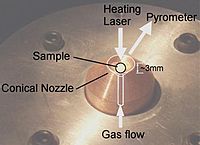Aerodynamic levitation

Do you like playing with toy cars or trains? When they move, they make sounds like vroom-vroom or choo-choo. But have you ever thought about what makes them move so easily? It's because they have wheels that help them glide smoothly on a flat surface. Now, let's talk about something similar but much cooler- Aerodynamic Levitation.
Aerodynamic Levitation means to hold something in the air without any physical support, like wheels or platforms. It's like magic but with science. Imagine you are walking in space, but suddenly you stop mid-air and float. It may sound weird, but it's possible, and scientists use this technology in many useful ways.
In aerodynamic levitation, air pressure plays a vital role. It is the same pressure that pushes you when you are pushed by the wind. When we blow air on an object, it creates a cushion-like effect, and the object starts to float on top of the air. That's how we make paper airplanes or blow balloons. Similarly, scientists use compressed air or streams of gas to levitate objects.
Aerodynamic levitation has many uses. The most common application is in high-speed transportation. Imagine you are in a train that moves so fast, but you feel like you are sitting in your living room. It's because the train uses aerodynamic levitation by creating a cushion of air between the train and the rail. This way, the train glides smoothly at high speed without any friction, which makes the ride faster, quieter, and much more comfortable.
Another use of aerodynamic levitation is in material research. Scientists use the technique to create an environment where they can study materials without any interference from other substances. For example, if they want to study the structure of a new type of metal, they levitate a tiny piece of it in the air to avoid it from touching any other objects. It helps them to study the material's properties without any alteration.
In conclusion, aerodynamic levitation is a technique that uses air pressure to hold objects in the air without any physical supports. It's used in transportation, material science, and many other fields where a controlled environment is needed.
Aerodynamic Levitation means to hold something in the air without any physical support, like wheels or platforms. It's like magic but with science. Imagine you are walking in space, but suddenly you stop mid-air and float. It may sound weird, but it's possible, and scientists use this technology in many useful ways.
In aerodynamic levitation, air pressure plays a vital role. It is the same pressure that pushes you when you are pushed by the wind. When we blow air on an object, it creates a cushion-like effect, and the object starts to float on top of the air. That's how we make paper airplanes or blow balloons. Similarly, scientists use compressed air or streams of gas to levitate objects.
Aerodynamic levitation has many uses. The most common application is in high-speed transportation. Imagine you are in a train that moves so fast, but you feel like you are sitting in your living room. It's because the train uses aerodynamic levitation by creating a cushion of air between the train and the rail. This way, the train glides smoothly at high speed without any friction, which makes the ride faster, quieter, and much more comfortable.
Another use of aerodynamic levitation is in material research. Scientists use the technique to create an environment where they can study materials without any interference from other substances. For example, if they want to study the structure of a new type of metal, they levitate a tiny piece of it in the air to avoid it from touching any other objects. It helps them to study the material's properties without any alteration.
In conclusion, aerodynamic levitation is a technique that uses air pressure to hold objects in the air without any physical supports. It's used in transportation, material science, and many other fields where a controlled environment is needed.
Related topics others have asked about:
